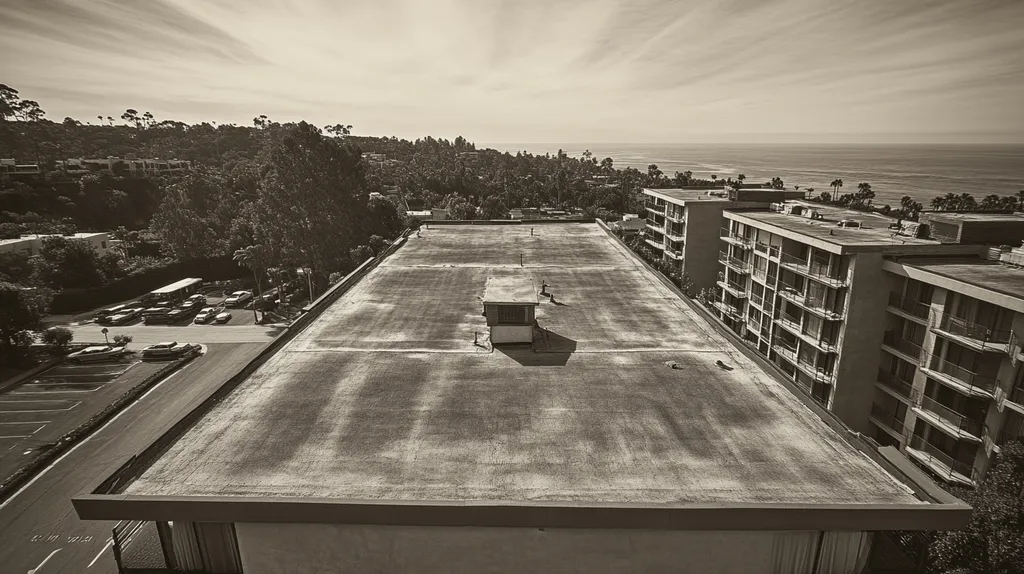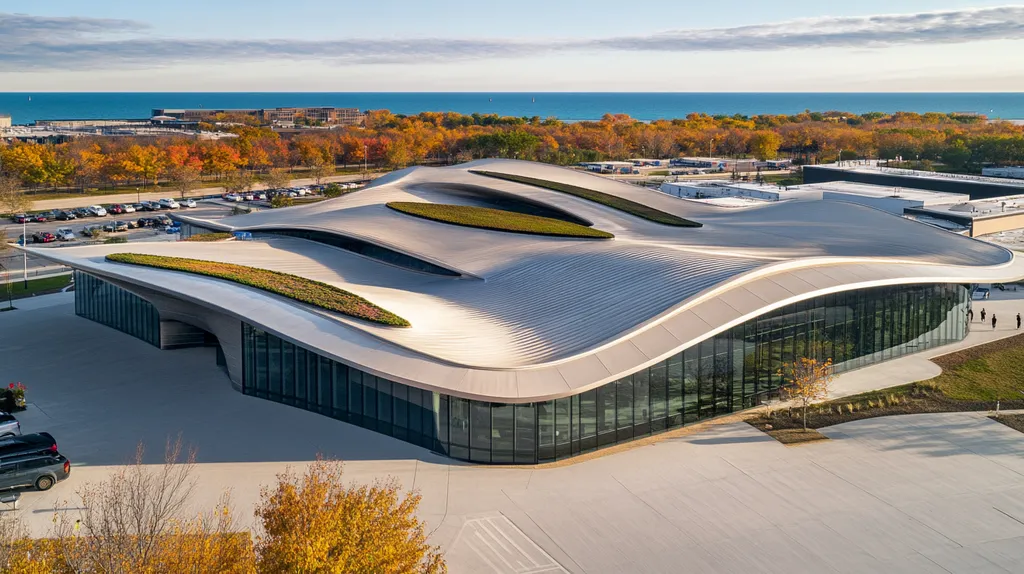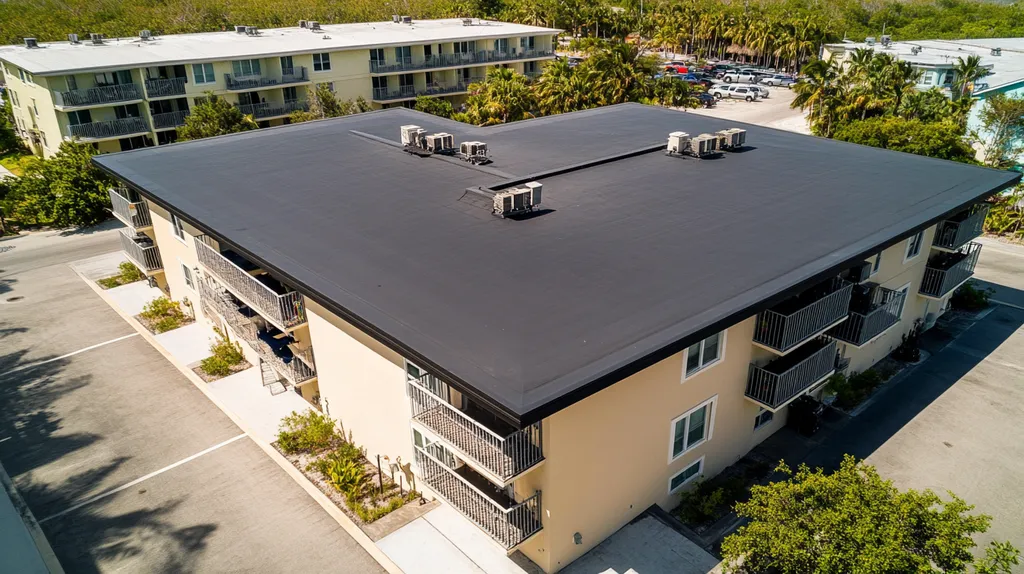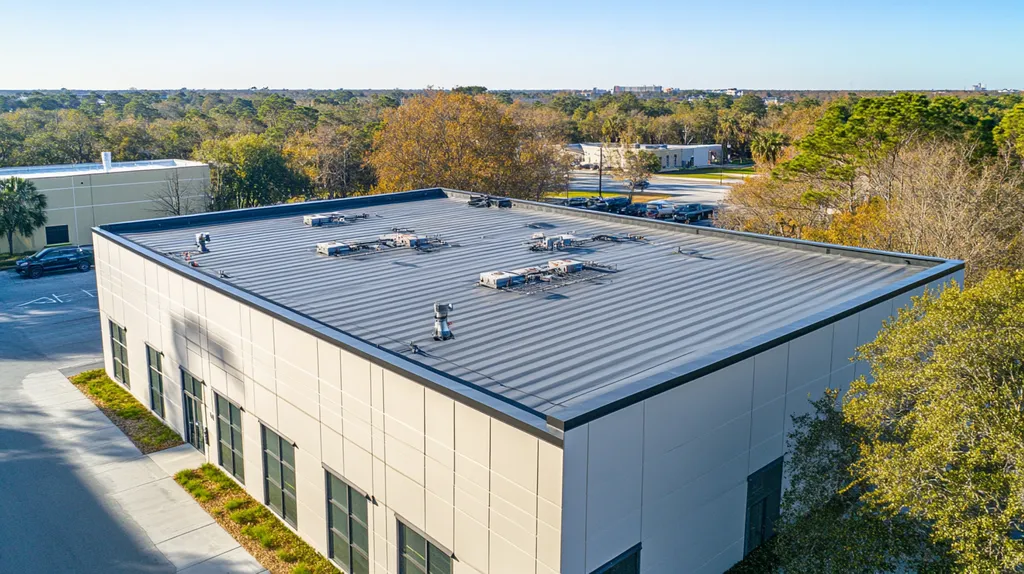Welcome to today’s Battle Royale featuring two roofing heavyweights: “Thermal Imaging” in the east corner versus “Manual Inspection” in the west!
Tonight’s showdown pits these contenders against each other across six punishing rounds designed to test every aspect of their performance for Commercial Roof Inspection.
At stake? Millions in potential costs, decades of building protection, and the critical performance demands of modern commercial and industrial facilities.
Our professional judging panel will evaluate each round on technical merit, real-world performance, and value delivery. After all six rounds, we’ll declare our ultimate champion.
Ladies and gentlemen, facility managers and building owners… it’s time to rumble!
ROUND 1: INITIAL COSTS & INSTALLATION
When a new commercial roof is installed, proper inspection can mean the difference between decades of protection and premature failure. Today’s facility managers face a critical choice between cutting-edge thermal imaging and traditional manual inspections. Making the wrong choice could result in hundreds of thousands in repairs, business interruption, and damaged inventory.
Material Expenses
The investment required for each inspection method varies dramatically. Thermal imaging equipment requires a substantial upfront investment, typically ranging from $6,000 to $15,000 for a commercial-grade infrared camera system and analysis software.
Manual inspection tools are considerably less expensive, usually totaling less than $1,000 for a complete kit including moisture meters, probes, and basic measuring equipment. However, these tools can’t detect subsurface issues until they become visible problems.
While thermal imaging carries higher initial costs, its ability to prevent major repairs through early detection provides superior value over time. For material expenses, manual inspection takes the ADVANTAGE.
Installation Complexity
Setting up a thermal imaging inspection requires precise timing and environmental conditions. Scans must be performed when temperature differentials are optimal, typically during dusk or dawn, and weather conditions must be suitable for accurate readings.
Manual inspections can be conducted under most conditions and don’t require special scheduling considerations. The process is straightforward, requiring only basic safety equipment and access to the roof surface.
Manual inspections win this category due to their flexibility and simplicity. For installation complexity, manual inspection claims the ADVANTAGE.
Project Timeline
Time efficiency is crucial in commercial roofing projects where every hour of delay impacts business operations. Thermal imaging can scan large roof areas quickly, typically completing a 50,000 square foot roof inspection in 2-3 hours.
Manual inspections of the same area often require 1-2 full days, as inspectors must physically examine every square foot of the roof surface. This extended timeline increases labor costs and prolongs potential business disruption.
The speed and efficiency of thermal imaging make it the clear winner for project timelines. For project timeline considerations, thermal imaging takes the ADVANTAGE.
ROUND 1 WINNER: TIE
ROUND 2: DURABILITY & LIFESPAN
Commercial roof failures can devastate businesses, with repair costs often exceeding $500,000 and forcing extended operational shutdowns. The choice between thermal imaging and manual inspection methods directly impacts how effectively these catastrophic failures can be prevented or caught early.
Property owners who choose the wrong inspection method risk missing critical warning signs that could lead to premature roof replacement or extensive water damage to inventory and equipment. Making an informed decision requires understanding how each method evaluates crucial durability factors.
Evaluating Material Durability
Thermal imaging technology can detect minute temperature variations that signal developing problems in roofing materials long before they become visible. These scans reveal hidden moisture infiltration, delamination, and insulation breakdown – all major threats to roof durability.
Manual inspections rely primarily on visual observation and physical probing of the roof surface. While effective for identifying obvious damage, this method cannot detect internal deterioration until it manifests as visible problems.
The comprehensive subsurface analysis provided by thermal imaging gives it a clear ADVANTAGE in evaluating material durability.
Assessing Lifespan Projections
Accurate lifespan forecasting requires understanding both surface and internal roof conditions. Thermal imaging provides detailed mapping of moisture patterns, heat loss areas, and material separation that could impact longevity.
Traditional manual inspections typically focus on surface age indicators like membrane wear, visible seam separation, and ponding water. This surface-level assessment often misses underlying conditions that could dramatically shorten roof life.
With its ability to identify hidden factors affecting roof longevity, thermal imaging takes the ADVANTAGE in lifespan assessment.
Long-Term Cost Implications
Early problem detection significantly impacts lifetime maintenance costs. Thermal imaging can identify issues when repairs cost pennies on the dollar compared to waiting for visible damage.
Manual inspections often catch problems only after they’ve developed into serious issues requiring extensive repairs. This reactive approach leads to higher lifetime maintenance costs and shorter intervals between major repairs.
The preventive capabilities of thermal imaging provide a clear ADVANTAGE in managing long-term costs.
ROUND 2 WINNER: THERMAL IMAGING
ROUND 3: PERFORMANCE FACTORS
Modern commercial roofing systems represent investments often exceeding $1 million, making inspection accuracy critical for protecting these valuable assets. As building technologies advance, facility managers must evaluate whether traditional manual methods can still adequately detect potential failures before they become catastrophic.
With sophisticated roofing assemblies becoming standard in commercial construction, the margin for error in inspections continues to shrink. The stakes are especially high for properties housing sensitive equipment or inventory that could be damaged by undetected leaks.
Detection Accuracy
The ability to precisely identify roofing issues before they escalate into major problems directly impacts maintenance costs and building protection. Thermal imaging technology can detect temperature variations as small as 0.1°C, revealing hidden moisture penetration and insulation failures long before visible damage occurs.
Manual inspections rely heavily on visual observation and physical probing of the roof surface. Even experienced inspectors can miss subtle signs of deterioration that haven’t yet manifested as visible damage.
While manual methods excel at identifying surface defects, they cannot reliably detect subsurface issues. The comprehensive detection capabilities of thermal imaging, especially for hidden problems, give it a clear ADVANTAGE in accuracy.
Time Efficiency
In commercial roofing, time equals money – both in inspection costs and potential business disruption. Thermal imaging systems can rapidly scan vast roof areas, typically completing a 100,000 square foot inspection in under 4 hours.
Manual inspections of the same area often require multiple days of careful visual examination and physical testing. This extended timeline increases labor costs and prolongs any interference with normal business operations.
The dramatic difference in inspection speed and minimal disruption make thermal imaging the clear winner. For time efficiency, thermal imaging takes the ADVANTAGE.
Long-term Impact
The true value of an inspection method lies in its ability to protect and extend roof life while minimizing lifetime maintenance costs. Thermal imaging creates detailed moisture maps and thermal profiles that serve as baseline data for tracking changes over time.
Traditional manual inspections provide limited historical data for comparison, making it difficult to track gradual deterioration. This reactive approach often leads to more frequent repairs and shortened roof life.
The superior tracking and preventive capabilities of thermal imaging result in better long-term outcomes. For long-term impact, thermal imaging claims the ADVANTAGE.
ROUND 3 WINNER: Thermal Imaging
ROUND 4: MAINTENANCE REQUIREMENTS
Modern commercial roofing systems require consistent maintenance to protect investments often exceeding seven figures. Without proper ongoing inspection and maintenance, even minor issues can escalate into catastrophic failures, leading to extensive damage, business interruption, and costly emergency repairs.
The choice between thermal imaging and manual inspection methods dramatically impacts how effectively maintenance needs are identified and addressed. Getting this decision wrong could mean missing critical warning signs until it’s too late.
Value of Regular Maintenance
Regular maintenance inspections serve as an early warning system for potential roofing failures. These evaluations help facility managers identify and address issues before they escalate into major problems requiring extensive repairs or premature roof replacement.
Thermal imaging provides comprehensive subsurface analysis during maintenance checks, detecting moisture infiltration, insulation breakdown, and membrane separation long before visible damage occurs. This technology creates detailed thermal maps that can be compared over time to track deterioration patterns.
Manual inspections rely primarily on visual observation and physical testing of the roof surface. While effective for identifying obvious damage, this method cannot detect internal problems until they manifest as visible issues.
For its ability to identify hidden maintenance needs early, thermal imaging takes the ADVANTAGE.
Frequency of Inspections
The frequency of required maintenance inspections directly impacts both operational costs and roof protection. More frequent inspections increase labor costs and potential business disruption but may catch problems earlier.
Thermal imaging systems can thoroughly evaluate roof conditions in a single annual inspection, with additional scans only needed after severe weather events. The comprehensive nature of these scans provides confidence in roof condition between scheduled maintenance.
Manual inspections typically require quarterly or bi-annual evaluations to maintain adequate oversight. This increased frequency stems from the inability to detect subsurface issues, requiring more frequent checks to catch problems as they become visible.
The reduced inspection frequency needed with thermal imaging earns it the ADVANTAGE.
Cost Implications of Maintenance
Maintenance costs represent a significant portion of total roof ownership expenses. The method chosen for maintenance inspections directly impacts both immediate costs and long-term financial outcomes.
Thermal imaging maintenance programs typically cost more per inspection but require fewer total inspections. The technology’s ability to detect problems early results in smaller, less expensive repairs and extends overall roof life.
Manual inspection programs have lower per-inspection costs but require more frequent evaluations. This approach often leads to more extensive repairs when problems are finally detected, resulting in higher lifetime maintenance expenses.
The superior long-term cost efficiency of thermal imaging gives it the ADVANTAGE.
ROUND 4 WINNER: THERMAL IMAGING
ROUND 5: SUSTAINABILITY CREDENTIALS
Today’s commercial buildings face unprecedented pressure to minimize environmental impact while maximizing energy efficiency. A poorly inspected roof can waste thousands in energy costs annually and significantly increase a building’s carbon footprint. The stakes are especially high for facilities pursuing green building certifications, where roofing performance directly impacts qualification.
Energy Efficiency and Performance
Roofing system efficiency directly impacts a building’s overall environmental footprint. Even minor thermal bridges or insulation gaps can lead to massive energy waste, particularly in climate-controlled facilities.
Thermal imaging technology can detect temperature variations as small as 0.1°C, instantly revealing areas of heat loss, moisture infiltration, and insulation breakdown. These scans create comprehensive thermal maps that guide targeted repairs to optimize energy performance.
Manual inspections struggle to identify subtle thermal inefficiencies hidden beneath the roof surface. Visual observations and physical probing cannot reliably detect heat loss patterns or insulation degradation until significant damage occurs.
For its superior ability to optimize energy performance, thermal imaging takes the ADVANTAGE.
Material Recycle and Waste Management
Sustainable roofing requires maximizing material lifespan and minimizing waste through timely repairs. Early problem detection allows targeted fixes that preserve existing materials rather than requiring full replacement.
Thermal imaging identifies developing issues before materials deteriorate beyond repair. This early warning enables preservation of existing materials through strategic maintenance rather than wholesale replacement.
Manual inspections often catch problems only after materials have degraded significantly. This delayed detection frequently results in extensive tear-offs and replacements that send serviceable materials to landfills prematurely.
The waste-reduction capabilities of thermal imaging earn it the ADVANTAGE.
Compliance with Green Standards
Modern sustainability certifications demand documented proof of building performance and ongoing maintenance. Roofing system efficiency plays a crucial role in achieving and maintaining these valuable credentials.
Thermal imaging provides quantifiable data on roof performance, insulation effectiveness, and moisture intrusion. These detailed reports satisfy certification requirements while creating historical performance baselines.
Traditional manual inspections generate limited documentation focused mainly on visible conditions. This lack of comprehensive performance data can jeopardize certification efforts and renewals.
The superior documentation and verification capabilities of thermal imaging secure the ADVANTAGE.
ROUND 5 WINNER: THERMAL IMAGING
ROUND 6: SPECIALIZED APPLICATIONS
Commercial roofing has evolved beyond simple waterproofing, with modern systems incorporating multiple layers and sophisticated materials. These complex assemblies demand specialized inspection approaches for critical scenarios like hidden moisture detection, cold storage facilities, and solar panel integration. Making the wrong choice in inspection methods can lead to devastating consequences, with repair costs often exceeding $250,000 when problems go undetected.
High-Tech Applications
Modern commercial roofs increasingly incorporate sophisticated elements like integrated solar arrays, green roof systems, and smart sensors. These advanced installations require precise evaluation methods to ensure proper function and prevent damage to expensive components.
Thermal imaging excels at analyzing these complex systems, detecting potential issues like heat buildup under solar panels or moisture problems in living roof sections. The technology can map subtle temperature variations that signal developing problems before they affect sensitive equipment.
Manual inspections struggle with these advanced applications, often unable to assess subsurface conditions or identify early-stage problems. Visual observation alone cannot effectively evaluate the complex interactions between modern roofing components.
For specialized high-tech applications, thermal imaging claims the ADVANTAGE.
Cold Storage Facilities
Temperature-controlled environments present unique inspection challenges, where even minor insulation failures can result in substantial energy waste and product loss. These facilities require precise evaluation of thermal barriers and vapor control layers.
Thermal imaging provides detailed analysis of temperature differentials, instantly revealing compromised insulation or vapor barrier failures. This technology can identify potential condensation points before moisture damage occurs.
Traditional manual inspections often miss critical issues in cold storage applications until visible damage appears. By then, extensive repairs are typically needed, and valuable inventory may already be compromised.
The superior detection capabilities for cold storage facilities give thermal imaging the ADVANTAGE.
Multi-Layer Systems
Contemporary commercial roofs often feature complex multi-layer assemblies with various materials serving distinct purposes. These sophisticated systems require thorough evaluation of each layer’s performance and interaction with adjacent components.
Thermal imaging can assess multiple layers simultaneously, detecting issues like delamination, trapped moisture, or insulation compression. The technology creates comprehensive profiles showing how different layers interact and perform.
Manual inspection methods can only evaluate the surface layer effectively, missing problems developing between layers. This limitation often leads to incomplete assessments and missed early warning signs.
For evaluating complex multi-layer systems, thermal imaging takes the ADVANTAGE.
ROUND 6 WINNER: THERMAL IMAGING
AND THE WINNER IS…
After six grueling rounds of technical evaluation, we have our verdict…
Ladies and gentlemen, in a stunning display of technical superiority, THERMAL IMAGING has dominated this matchup with FIVE decisive round victories!
The champion’s combination of early detection capabilities, comprehensive analysis, and superior long-term cost management proved unstoppable across Durability, Performance, Maintenance, Sustainability, and Specialized Applications. Only in Round 1’s Initial Costs battle did our competitors draw even.
But don’t count Manual Inspection out completely! This veteran contender still delivers reliable performance for smaller facilities, basic roof assemblies, and situations requiring immediate, on-the-spot evaluation with minimal equipment setup.
*Important Ringside Notice*
Every building brings unique challenges to the inspection arena. Local climate conditions, specific roofing materials, and individual facility requirements can all impact inspection method effectiveness. This analysis provides general guidance but cannot account for all variables. Property owners should consult qualified roofing professionals who can evaluate their specific situation before making a final decision.
Remember, champions: In the high-stakes world of commercial roofing, matching your facility’s specific needs to the right inspection method isn’t just about winning rounds – it’s about protecting millions in assets and decades of performance. Choose your corner wisely!
FREQUENTLY ASKED QUESTIONS
Q. What are the costs of a commercial roof inspection?
A. Thermal imaging inspections involve upfront costs ranging from $6,000 to $15,000 for equipment. In contrast, manual inspection tools cost less than $1,000 but miss many early-stage defects that can lead to costly repairs later. Therefore, while the initial expense of thermal imaging is higher, its potential savings over time can be significant.
Q. How does inspection method affect a commercial roof’s durability?
A. Thermal imaging can detect temperature variations indicating hidden issues, allowing preventive measures. In contrast, manual inspections primarily rely on visual cues, missing subsurface problems until it’s too late. By identifying potential threats early, thermal imaging helps ensure better durability for the roof.
Q. Which inspection method is faster for a commercial roof?
A. Thermal imaging can inspect large areas quickly, covering 50,000 square feet in just 2-3 hours. Manual inspections, however, often take 1-2 full days due to the physical examination required. This difference impacts both labor costs and potential operational disruptions.
Q. What are the maintenance requirements for a commercial roof?
A. Regular maintenance inspections are crucial for identifying issues before they escalate. Thermal imaging allows for comprehensive scans during maintenance, catching problems early. Manual inspections, while useful, require more frequent checks to monitor conditions, increasing labor demands and costs over time.
Q. How does each method contribute to sustainability in roofing?
A. Thermal imaging promotes sustainability by detecting insulation failures early, reducing energy consumption. This proactive approach preserves existing materials, minimizing waste. Manual inspections may lead to unnecessary replacements of materials, generating additional waste and impacting the environment negatively.
Q. What specialized applications benefit from thermal imaging in commercial roofs?
A. Thermal imaging is especially beneficial for high-tech applications, like solar panel assessments and tracking moisture in cold storage facilities. It accurately detects issues that may not be visible externally, preventing costly repairs and ensuring efficient performance of specialized roofing systems.
Q. Why is choosing the right inspection method critical for a commercial roof?
A. The wrong choice can lead to missing critical issues that result in catastrophic failures. Selecting an inspection method that effectively detects hidden problems helps property owners avoid significant repair costs and extending operational interruptions, protecting their investments and ensuring business continuity.











